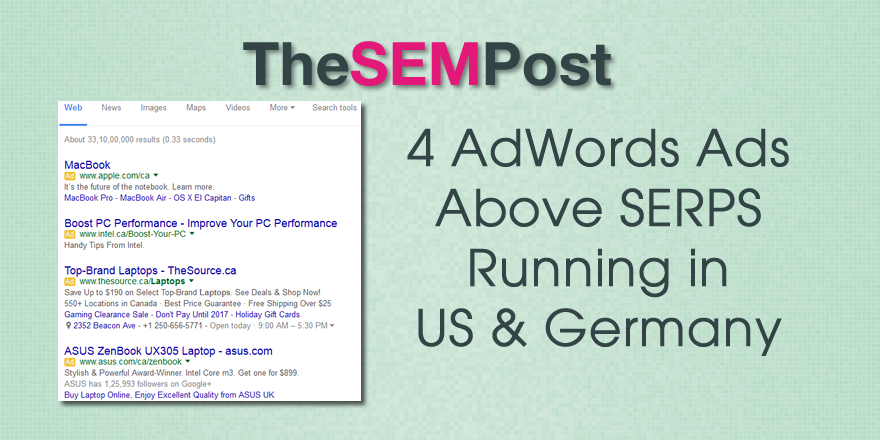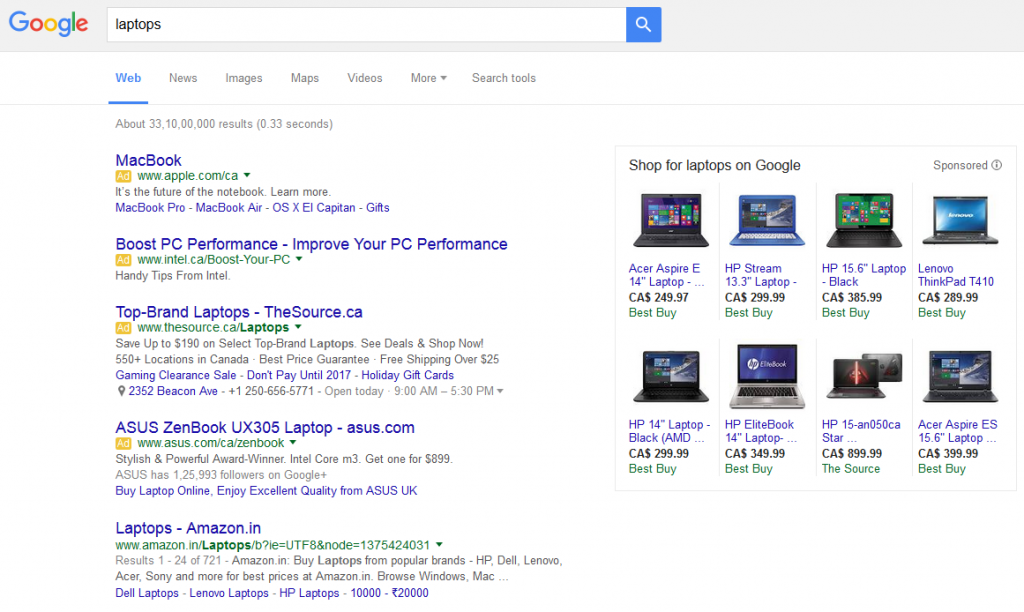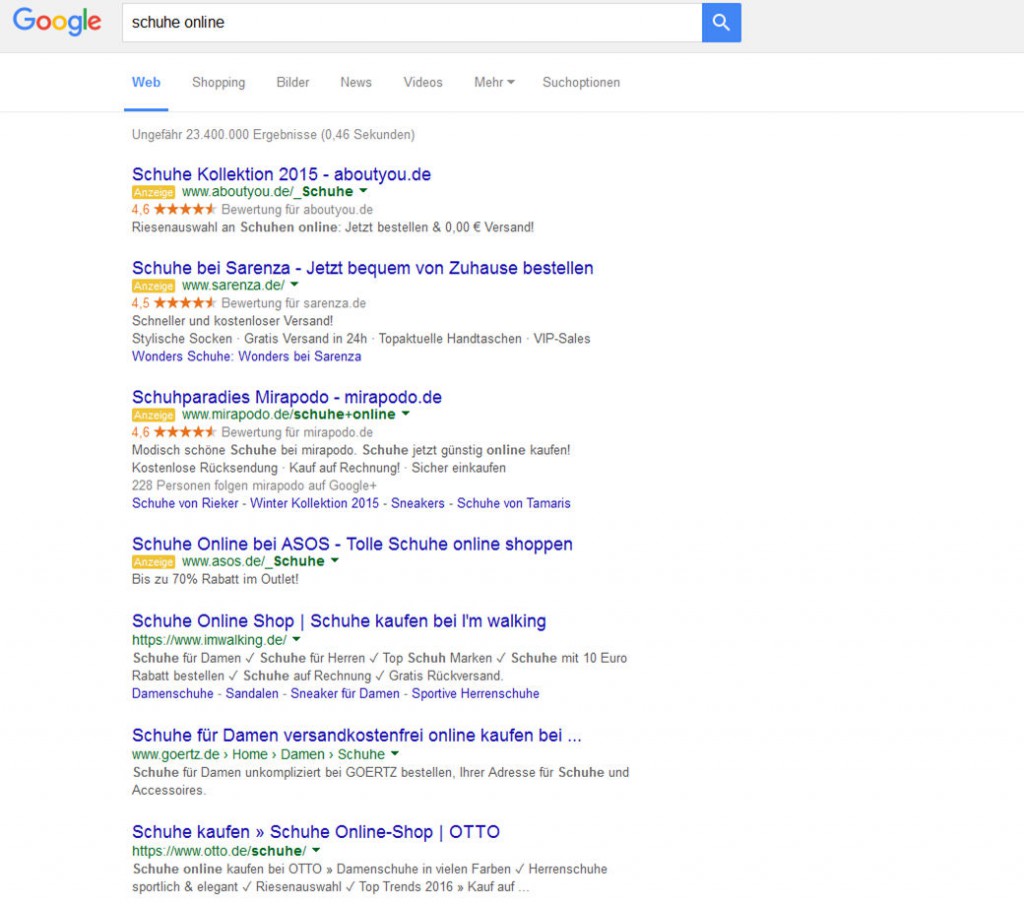 Yesterday we spotted a Google AdWords test running in Google India where they were placing four AdWords ads at the top of the search results. We have also confirmed that this is also being tested on a limited basis in both the US and Germany too.
Yesterday we spotted a Google AdWords test running in Google India where they were placing four AdWords ads at the top of the search results. We have also confirmed that this is also being tested on a limited basis in both the US and Germany too.
For those who haven’t seen it in action, here is what it looks like:
 Dr. Pete Meyers checked Mozcast data from last night’s run and discovered multiple search queries that showed 4 ads above the Google search results instead of the maximum three. He said they showed on about 1% of the keywords they tracked, which would bring it in line with Google’s 1% tests they run in the search results.
Dr. Pete Meyers checked Mozcast data from last night’s run and discovered multiple search queries that showed 4 ads above the Google search results instead of the maximum three. He said they showed on about 1% of the keywords they tracked, which would bring it in line with Google’s 1% tests they run in the search results.
SEO Südwest also spotted them in the search results too, running in Germany. Here is an example:
 This one also appears to be a limited test, as I couldn’t trigger it.
This one also appears to be a limited test, as I couldn’t trigger it.
This is really big for all advertisers looking to maximize their exposure in the search results. But not so good for those with great organic rankings, since it does push those results down further.
There also doesn’t seem to be any limit on the ad extensions being shown, which could have been a possibility in order to reduce the screen real estate of the AdWords ads. After all, it could have been an option to show more ads in the usual 3-ad space in the search results if they didn’t always show things like site links or reviews. But this could have a negative impact on the AdWords ads, since it is often things like review starts or site links that cause a searcher to click on an ad over another result.
We should have some screen shots this weekend from Mozcast as well, although I am also trying to trigger it on both US and Canada.
Jonathan Jones says
In b4 ‘SEO is dead’! Possibly Google looking to make up the losses they are making because of ad block – though way to alienate even more of the user base by getting more to install ad block….
Camila says
In brazil too: https://www.pt.adwords-community.com/t5/Novo-no-AdWords/4-an%C3%BAncios-no-topo-da-p%C3%A1gina/m-p/140458
Amirul Faisyal says
We have seen it in Malaysia too as what I covered few weeks ago here:
http://www.prospekdigital.com/2015/11/google-sedang-menguji-4-iklan-di-atas-keputusan-carian-mereka/
Wouter Nieuwerth says
This test is also active in the Netherlands and not just on desktop, but also on mobile devices.
https://www.adwise.nl/blog/google-test-ook-in-nederland-met-4-topposities-voor-adwords.html
(in Dutch)
joe barbarossa says
Google for a locksmith in any larger American city. Now instead of 3 prominently placed fraudulent ads (that Google knows perfectly well are entirely deceptive), there will be 4 big fraudulent ads instead. The claim “Only $15 service!” are bald-faced lies. They mean that their service fee is $15, which is 4 times less than the market’s going-rate for that service among locksmiths, plumbers, electricians, towing. (Look up average prices for locksmiths to see the average mobile service fee is $68). Every other claim are lies as well. They’re not local. They’re not even locksmith companies, they’re just call centers that refuse to name what the price of their services will be, telling lies on the phone about “the locksmith needs to see your locks first” when in fact they don’t. They get the address of the caller and sell it as a “lead” to whomever signs up to buy those leads — anonymous uninsured untrained nobodies. The average cost of an auto lockout is $60 total among real locksmiths, and it averages $120 among these scammers. People hire them because they say it’s $15 mobile service and $25 or more for the labor costs, and that sounds cheaper than a straightforward “It’s $60” to people.
So, what’s happening is more visibility for more well-known fraudulent ads that are knowingly published as such by “Don’t Be Evil” Google. (It doesn’t matter if there’s a legal loophole that allows them to publish deceptive adverts, legal/illegal and right and wrong are two separate issues here).
I was wondering why my business was suddenly doing half the business it had been doing. I think it’s the increased visibility of Google’s published lies. There’s no competing with the prominently placed, outrageous lies. What could I possibly publish to compete with low-balling of this magnitude that wouldn’t just be money lost? Google’s traded good money for bad by preferring known fraudulent ads in their Adwords space, and now they’re seeking to profit from it better.